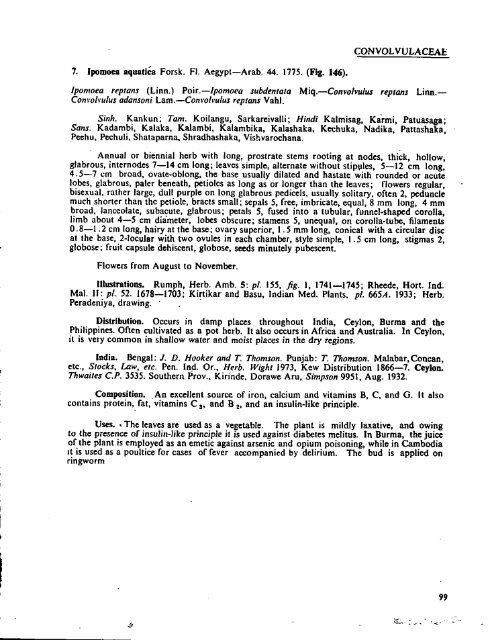,r\/*> - National Science Foundation
,r\/*> - National Science Foundation
,r\/*> - National Science Foundation
You also want an ePaper? Increase the reach of your titles
YUMPU automatically turns print PDFs into web optimized ePapers that Google loves.
7. Ipomoea aquatica Forsk. Fl. Aegypt—Arab. 44. 1775. (Fig. 146).<br />
CONVOLVULACEAE<br />
Ipomoea reptans (Linn.) Poir.—Ipomoea subdentata Miq.—Convolvulus rep tans Linn.—<br />
Convolvulus adansoni Lam.—Convolvulus reptans Vahl.<br />
Sinh. Kankun; Tarn. Koilangu, Sarkareivalli; Hindi Kalmisag, Karmi, Patuasaga;<br />
Sans. Kadambi, Kalaka, Kalambi, Kalambika, Kalashaka, Kechuka, Nadika, Pattashaka,<br />
Peehu. Pechuli. Shataparna, Shradhashaka, Vishvarochana.<br />
Annual or biennial herb with long, prostrate stems rooting at nodes, thick, hollow,<br />
glabrous, internodes 7—14 cm long; leaves simple, alternate without stipules, 5—12 cm long,<br />
4.5—7 cm broad, ovate-oblong, the base usually dilated and hastate with rounded or acute<br />
lobes, glabrous, paler beneath, petioles as long as or longer than the leaves; flowers regular,<br />
bisexual, rather large, dull purple on long glabrous pedicels, usually solitary, often 2, peduncle<br />
much shorter than the petiole, bracts small; sepals 5, free, imbricate, equal, 8 mm long, 4 mm<br />
broad, lanceolate, subacute, glabrous; petals 5, fused into a tubular, funnel-shaped corolla,<br />
limb about 4—5 cm diameter, lobes obscure; stamens 5, unequal, on corolla-tube, filaments<br />
0.8—1.2 cm long, hairy at the base; ovary superior, 1.5 mm long, conical with a circular disc<br />
at the base, 2-locuIar with two ovules in each chamber, style simple, 1.5 cm long, stigmas 2,<br />
globose; fruit capsule dehiscent, globose, seeds minutely pubescent.<br />
Flowers from August to November.<br />
Illustrations. Rumph, Herb. Amb. 5: pi 155, fig. 1, 1741—1745; Rheede, Hort. Ind.<br />
Mai. II: pi 52. 1678—1703; Kirtikar and Basu, Indian Med. Plants, pi 665,4. 1933; Herb.<br />
Peradeniya, drawing.<br />
Distribution. Occurs in damp places throughout India, Ceylon, Burma and the<br />
Philippines. Often cultivated as a pot herb. It also occurs in Africa and Australia. In Ceylon,<br />
it is very common in shallow water and moist places in the dry regions.<br />
India. Bengal: /. D. Hooker and T. Thomson. Punjab: T. Thomson. Malabar,Concan,<br />
etc., Stocks, Law, etc. Pen. Ind. Or., Herb. Wight 1973, Kew Distribution 1866—7. Ceylon.<br />
Thwaites CP. 3535. Southern Prov., Kirindc, Dorawe Am, Simpson 9951, Aug. 1932.<br />
Composition. An excellent source of iron, calcium and vitamins B, C, and G. It also<br />
contains protein, fat, vitamins C 3, and B 2, and an insulin-like principle.<br />
Uses. • The leaves are used as a vegetable. The plant is mildly laxative, and owing<br />
to the presence of insulin-like principle it is used against diabetes melitus. In Burma, the juice<br />
of the plant is employed as an emetic against arsenic and opium poisoning, while in Cambodia<br />
it is used as a poultice for cases of fever accompanied by delirium. The bud is applied on<br />
ringworm<br />
99
















